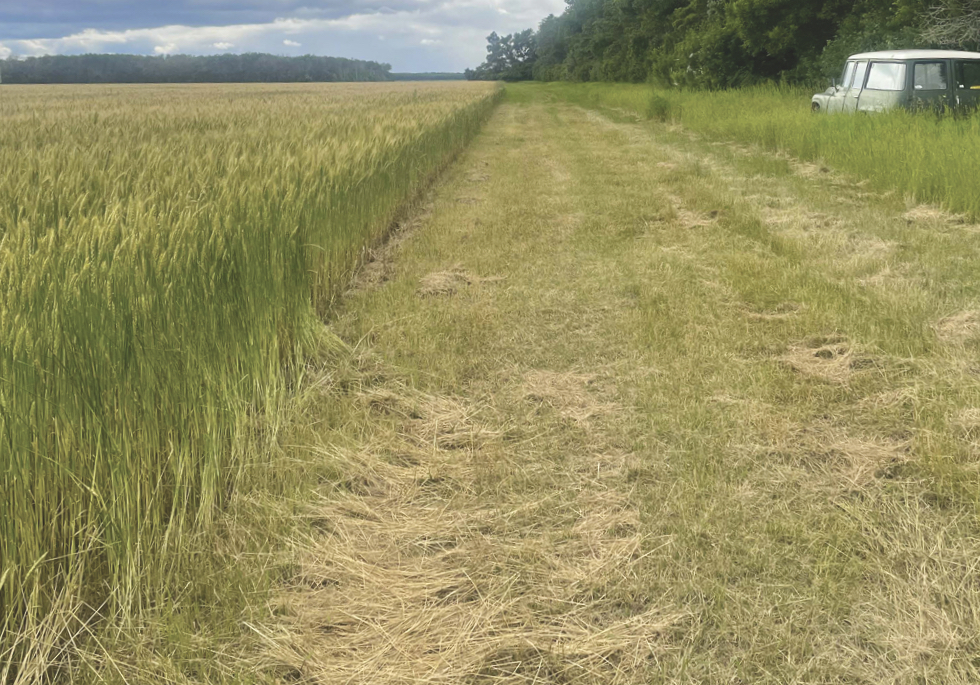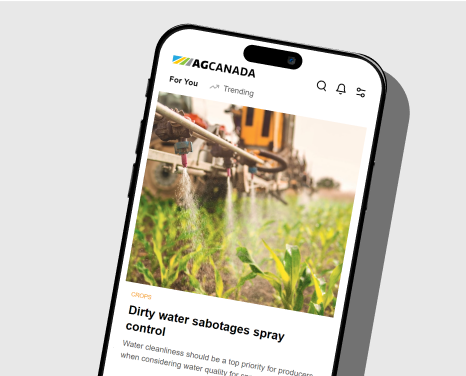Are buffer strips right for your farm?
A Manitoba farmer discusses how his farm benefits from the practice
By Jim Timlick
| 6 min read

This 15-foot buffer strip on the southern portion of Hardman’s farm helps separate a winter wheat field from nearby trees and makes it easier to harvest the crop. Photo: Courtesy John Hardman
John Hardman learned much of what he knows about farming from his father. Now Hardman owns Crooked Creek Farms near Dauphin, Man., which he has run for the past 40 years.
He succeeded his father, Edwin, who farmed the same land for nearly half a century.
One of the most enduring lessons Hardman learned from his father was the value of planting buffer strips near the waterways that criss-cross the family farm. Many of them have been around since his father ran the farm, and Hardman has continued the tradition while slowly growing the operation.
“They’ve been on our farm here all of my life,” Hardman says of the buffer strips on his property. “They’ve just always been there. I haven’t known any different.
“Some people seem to want to build a farm right to the edge and don’t want to think about losing any acres (to buffer strips). I don’t think of it as a loss of acres. I think it’s just a matter of farming the ones we do have better.
“Some things don’t always make you money, but it’s like the environment is thanking you for them. Because we farm small, we try to be good stewards of the land by not farming right to the edge.”
Protective area
A buffer strip is a protective area of permanent vegetation between a farm field and waterway or adjoining piece of land that serves to protect the quality of that water or land. It helps to slow and filter storm runoff while holding soil in place, thereby reducing erosion and preventing phosphorus from reaching nearby lakes.
Buffer strips can be established using a variety of plants, including native grasses and perennial crops such as hay.
When Hardman bought 80 acres of nearby farmland in the early 1990s, one of the first things he did — with some help from a local watershed program — was plant buffer strips on two sides of the property that had been previously farmed right to the edge.
Those kinds of environmental efforts earned Crooked Creek Farms a pair of Manitoba Conservation Awards in 1989 and again in 1999. Still, Hardman acknowledges not everyone is a fan of his buffer strips.
“I’ve had a lot of people question when we do leave strips around the edges, why we’re doing that. I guess it’s not normal around here.”
Normal or not, the strips have had a significant effect on Hardman’s operation. Soil erosion is rare on his 750-acre grain farm and chemical runoff has been greatly reduced.
Another benefit of the buffer strips is that they allow Hardman to turn larger pieces of equipment on those spots and reduce soil compaction in other parts of a field where cash crops are grown.
They can also be used to park gravity boxes for grain storage, further reducing soil compaction.
In addition to the environmental benefits they provide on his farm, Hardman says buffer strips also deliver logistical assistance by making it easier to scout his fields.
In most cases, Hardman has grown timothy or brome grasses, and in a few cases alfalfa, to build buffer strips on his farm. In some years, the strips have produced as much as 35 bales of hay, which he trades with a neighbouring farmer in exchange for mechanical services.
More attention
While buffer strips have been around for nearly as long as farming, they appear to be getting more attention of late, according to Trevor Wallace, a nutrient management specialist with Alberta Agriculture and Irrigation.
Part of the reason, he says, is that more growers see their value as a revenue source (livestock feed) or for environmental and societal benefits (erosion control or sanctuaries for pollinators).
“For some, buffers provide logistical benefits, such as equipment accommodation. Producers are seeing a number of benefits from buffers that at one time were not considered or perceived as a benefit,” says Wallace, who helped author the Nutrient Management Planning Guide for Alberta.
That said, preventing soil erosion remains a key benefit of buffer strips, according to Wallace. That’s especially true if they are designed to fit the geography of the area where they are planted.
“If they’re made to contour the land, they can significantly reduce (soil erosion). If not designed properly, you can be talking about potential losses of soil every year, which can be quite significant for the farmer.”
Wallace says it’s important for farmers to understand they shouldn’t take a one-size-fits-all approach to planting strips. Although 30-foot-wide strips are standard on many farms, that may be too wide or too narrow in many instances, he says.
“The problem with that is some parts of those 30 feet are probably way bigger than they need to be from an impact point of view. There’s no runoff crossing that point. And some parts of it might be too small because all the water flows through it,” he says.
Growers who contemplate buffer strips should first determine what they will be used for, says Wallace. Is it for erosion prevention or spray drift mitigation or both? Is creating a haven for pollinators the priority?
“That’s going to dictate not only how they design it and where they put it, but its size and then the appropriate vegetation for the area,” he says.
“From an economic point of view, I’ve taken less land from my crop production (because) we’re designing and putting the buffer where it provides the greatest benefit versus a uniform approach. It’s about looking at the landscape with a couple of different lenses.”
Farmers may want to hire someone to shoot aerial images of the farm so they can tailor buffer strips to the geography where they will be planted.
Wallace says that while most vegetation used in buffer strips is low maintenance, that doesn’t mean no maintenance. He suggests formulating a long-term maintenance plan for buffer strip areas to ensure they remain healthy and functional.
Hardman’s advice is to start small. Begin with one or two quarter sections. If that works out, expand to other areas of the operation.
He also suggests seeking help from organizations such as the local watershed district, which can provide technical advice and, in some cases, financial assistance.
Hardman says picking the right spot for buffer strips is important to ensure they achieve their ultimate potential.
“You don’t necessarily need to have a strip completely around all of your fields,” he says. “Look at where you’re seeing problems, especially erosion problems, and try to address those a little bit by putting a buffer strip in there. Target where you put them. That may not always be possible, but that’s how we try to farm here.”
Although Hardman doesn’t need convincing about the merits of buffer strips, he knows not everyone agrees. Some growers refuse to install them, which negates the positive effect of those around them who do.
He would like local governments to offer an incentive program to get more farmers on board.
“All of the farmers have to be on board and do our part. There needs to be some kind of incentivization or something along a waterway to get all the farmers on board where you have to keep X number of feet of them.”
– Jim Timlick writes for Grainews magazine. See more photos from this article in the Dec. 5, 2023 issue of Grainews.


